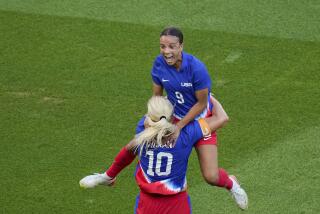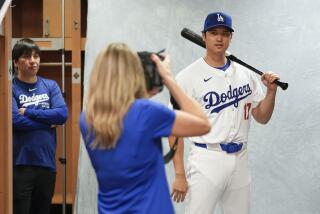Soccer teams make a uniform statement
- Share via
NEW YORK — World Cup team uniforms -- “kits” as they’re called in most of the soccer-loving world -- are not just a sideline topic. They are the face of a nation, and perhaps even a tactical tool as well.
Carefully designed for the quadrennial event by huge athleticwear companies like Nike, Adidas and Puma, the soccer players’ sleek jerseys have been easily adopted by fans off the field as both fashion and patriotic statements. On the field, some say, the uniforms’ fabric, design and color can give a team a subtle edge.
So who’s got a winning design?
Check out the third-ranked Netherlands, says Leatrice Eiseman, director of the Pantone Color Institute, a color research and information center. The Dutch jerseys feature orange and a touch of blue, a good juxtaposition of cool and warm, Eiseman says. The blue radiates confidence and consistency, while there’s a fire to orange.
“You can’t ignore this team,” Eiseman says.
The Dutch are playing in outfits designed by Nike, which created jerseys for eight countries. The “home” orange jersey was inspired by the 1959 national team design, and it gets fashion kudos for being the only one in the tournament with a trend-right polo collar. The design for the white “away” jerseys with diagonal orange and blue stripes dates to 1905, when the first national team shirt debuted. (All teams have two uniform designs.)
Nike began the World Cup project three years ago, sending researchers and designers to each country to soak up the culture, says Peter Hudson, the brand’s global creative director.
“Giving each team a kit based on their colors and badge was no longer acceptable. To be truly relevant and connect with each of the teams, we had to deliver something individual for each team,” says Hudson, who has split allegiances between his native England -- not a Nike team -- and Brazil, for which he personally designed the solid yellow and solid blue kits.
“It was about finding a balance in the jerseys. How do you pay reverence and respect to the teams themselves? We were not as interested in overbranding.”
Nike’s Sphere Dry fabric is used in all the jerseys. It’s supposed to keep athletes drier and cooler by wicking away moisture. There also are nodes on the underside of the jersey that keep the shirt from clinging.
But even with just a subtle Nike swoosh on the jersey and one on the shorts, this World Cup surely is lining the pockets of sports-gear companies: There’s been a 300% increase in sales of the Nike’s World Cup wear since the 2002 tournament, with 2.4 million kits sold globally. The bestsellers in the United States are Mexico, U.S. and Brazil.
History, more so than psychology, played a role in several designs: The Dutch home jersey has a shield behind the team’s crest in a baby blue color that was used in ’59. And for the Brazilian home jersey, Nike returned to a softer, sun-kissed and traditional Brazilian yellow instead of the citrus shade that was featured on the jerseys for the 2002 World Cup.
The Americans wanted a jersey that was bold and iconic, which isn’t dissimilar to what the team always asks for, Hudson says. But there was a collective decision made to make it cleaner and more sophisticated than in the past. The stripes in the American jerseys and socks pay homage to the uniforms the U.S. wore in its surprise upset of England in the 1950 World Cup. Despite the new look, the U.S. lost to Ghana, 2-1, Thursday and was eliminated from the competition.
What will likely carry over beyond the soccer tournament? Nylon shorts replacing tighter knit ones at the gym and the nylon pullover pushing aside the hoodie, predicts Tom Julian, senior vice president of trends at ad agency McCann Erickson.
“It fits in with the sleeker, younger wardrobe of today,” says Julian. Unlike the clunky high-top sneaker that complemented hip-hop fashion, the soccer shoe, even if it is the spectator version, has a slim look that’s very Euro-chic cool.
“There’s a lifestyle factor here,” Julian adds. “The whole soccer demeanor fits in with the fashion person who shops at H&M; or Zara but also the collegiate who shops at J.Crew and Abercrombie.”
More to Read
Go beyond the scoreboard
Get the latest on L.A.'s teams in the daily Sports Report newsletter.
You may occasionally receive promotional content from the Los Angeles Times.







